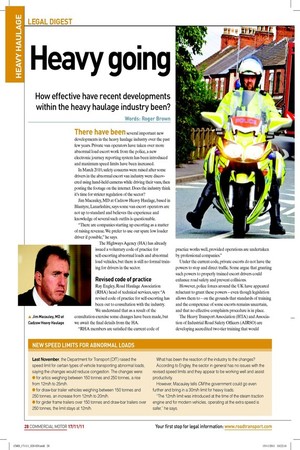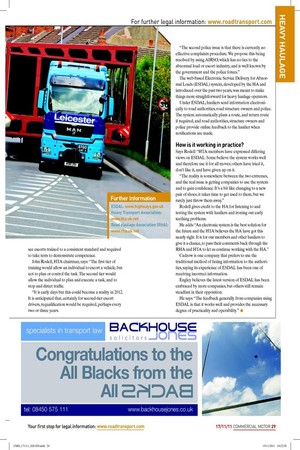Heavy going
Page 20

Page 21

If you've noticed an error in this article please click here to report it so we can fix it.
How effective have recent developments within the heavy haulage industry been?
Words: Roger Brown There have been several important new
developments in the heavy haulage industry over the past few years. Private van operators have taken over more abnormal load escort work from the police, a new electronic journey reporting system has been introduced and maximum speed limits have been increased.
In March 2010, safety concerns were raised after some drivers in the abnormal escort van industry were discovered using hand-held cameras while driving their vans, then posting the footage on the internet. Does the industry think it’s time for stricter regulation of the sector?
Jim Macauley, MD at Cadzow Heavy Haulage, based in Blantyre, Lanarkshire, says some van escort operators are not up to standard and believes the experience and knowledge of several such outits is questionable.
“There are companies starting up escorting as a matter of raising revenue. We prefer to use our spare low loader driver if possible,” he says.
The Highways Agency (HA) has already issued a voluntary code of practice for self-escorting abnormal loads and abnormal load vehicles, but there is still no formal training for drivers in the sector.
Revised code of practice
Ray Engley, Road Haulage Association (RHA) head of technical services, says: “A revised code of practice for self-escorting has been out to consultation with the industry. We understand that as a result of the consultation exercise some changes have been made, but we await the inal details from the HA.
“RHA members are satisied the current code of practice works well, provided operations are undertaken by professional companies.” Under the current code, private escorts do not have the powers to stop and direct trafic. Some argue that granting such powers to properly trained escort drivers could enhance road safety and prevent collisions.
However, police forces around the UK have appeared reluctant to grant these powers – even though legislation allows them to – on the grounds that standards of training and the competence of some escorts remains uncertain, and that no effective complaints procedure is in place.
The Heavy Transport Association (HTA) and Association of Industrial Road Safety Oficers (AIRSO) are developing accredited two-tier training that would see escorts trained to a consistent standard and required to take tests to demonstrate competence.
John Rodell, HTA chairman, says: “The irst tier of training would allow an individual to escort a vehicle, but not to plan or control the task. The second tier would allow the individual to plan and execute a task, and to stop and direct trafic.
“It is early days but this could become a reality in 2012. It is anticipated that, certainly for second-tier escort
AllBlacks:Backhouse advert 24/0/11 14:40 drivers, requaliication would be required, perhaps every
two or three years. “The second police issue is that there is currently no effective complaints procedure. We propose this being resolved by using AIRSO, which has no ties to the abnormal load or escort industry, and is well known by the government and the police forces.” The web-based Electronic Service Delivery for Abnormal Loads (ESDAL) system, developed by the HA and introduced over the past two years, was meant to make things more straightforward for heavy haulage operators.
Under ESDAL, hauliers send information electronically to road authorities, road structure owners and police. The system automatically plans a route, and return route if required, and road authorities, structure owners and police provide online feedback to the haulier when notiications are made.
How is it working in practice?
Says Rodell: “HTA members have expressed differing views on ESDAL. Some believe the system works well and therefore use it for all moves; others have tried it, don’t like it, and have given up on it.
“The reality is somewhere between the two extremes, and the real issue is getting companies to use the system and to gain conidence. It’s a bit like changing to a new pair of shoes; it takes time to get used to them, but we rarely just throw them away.” Rodell gives credit to the HA for listening to and testing the system with hauliers and ironing out early teething problems.
He adds: “An electronic system is the best solution for the future and the HTA believes the HA have got this nearly right. It is for our members and other hauliers to give it a chance, to pass their comments back through the RHA and HTA to let us continue working with the HA.” Cadzow is one company that prefers to use the traditional method of faxing information to the authorities, saying its experience of ESDAL has been one of receiving incorrect information.
Engley believes the latest version of ESDAL has been embraced by more companies, but others still remain steadfast in their opposition.
He says: “The feedback generally from companies using ESDAL is that it works well and provides the necessary degree of practicality and operability.” ■










































